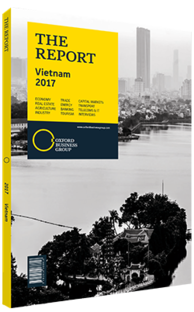Vietnam's central bank moves to currency basket peg
As part of its remit of maintaining monetary stability, the State Bank of Vietnam (SBV) manages the dong’s exchange rate against the US dollar, with an eye on preventing sharp depreciation. In recent years, it has loosened the dollar peg and moved in the direction of market rates. The exchange rate regime is sometimes described as a managed float, and other times a crawling peg, containing elements of both systems. The dong-to-dollar reference rate is set by the SBV, with the dong allowed to trade within a 3% band.
Freer Float
In 2015 the SBV made several moves to allow the dong to depreciate, in an environment in which a number of Asian economies were moving to devalue their currencies, while also encouraging a freer float in a bid to shield the economy from external and domestic shocks. The depreciation of the Chinese yuan in particular in 2015 had dragged currencies across Asia lower, and allowing the dong to drop was seen as necessary both to maintain export growth and to prevent expensive foreign exchange (forex) interventions by the SBV. In the first half of the year, the reference rate against the dollar was cut by 2% in two steps. In August, the trading band was widened first from +/- 1% band to +/- 2%, and then to +/-3%, while the reference rate was cut again, by 1%.
However, in December 2015, the dong hit the bottom of its trading band. Pressures on the exchange rate rose, with hoarding of dollars as speculation rose about another devaluation, and trading orders made it clear there was a gap between the SBV’s policy and market sentiment. As dollars were bought up and the central bank’s interventions limited, reserves dropped to around $28.3bn, equivalent to less than two months of imports. The US Federal Reserve’s first interest rate rise since 2006 further complicated the picture. With these factors at play alongside historically low inflation, the SBV saw a window of opportunity and redefined its reference rate, allowing it to shift on a daily basis. The reference rate now takes into account three factors: the previous day’s dong-dollar exchange rate, exchange rates of countries with sizeable trade and financial ties with Vietnam, and domestic macroeconomic conditions.
Stabiliser
Despite concerns in 2016 that the dong would once more come under pressure, the $:VND exchange rate remained fairly stable, with the exception of two spikes in August and December that quickly receded. Vietnam’s strong economic performance overall was one central factor buoying the currency, while the Fed’s slower-than-expected monetary tightening was another. Nonetheless, in November 2016 the SBV once again stated that it would be willing to use its dollar reserves to further stabilise the exchange rate if necessary.
It increasingly has the wherewithal to do so. The country’s foreign exchange reserves hit an all-time high of $41bn in January 2017, driven by FDI and remittances, which supported the SBV’s programme of dollar purchases in the first half of 2016, when it made acquisitions of around $8bn. The purchases were met with approval by the IMF.
With the exchange rate now more clearly determined by the market, there is less incentive to hoard dollars in the expectation of devaluation. Overall, the move seems to have benefitted economic stability. In a July 2016 staff report about Vietnam, the IMF encouraged the SBV to use the exchange rate to absorb external shocks and to continue to shift towards an inflation-based monetary policy, with less emphasis on exchange stabilisation.
The SBV’s monetary policy in 2017 will see payment means expand by between 16% and 18%, along with credit increases of 18%. This will be adjusted with the current status to allow financial institutions to expand high-quality credit, while keeping the non-performing loan ratio at less than 3%. This will help provide capital flow for the economy and increase the ability of businesses and individuals to borrow money.
You have reached the limit of premium articles you can view for free.
Choose from the options below to purchase print or digital editions of our Reports. You can also purchase a website subscription giving you unlimited access to all of our Reports online for 12 months.
If you have already purchased this Report or have a website subscription, please login to continue.

